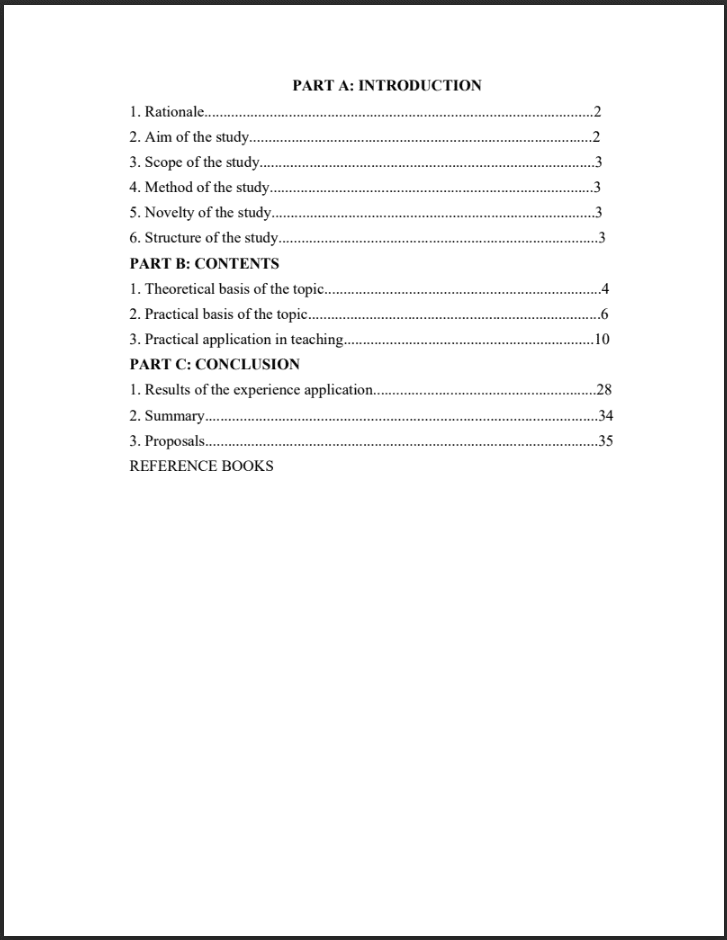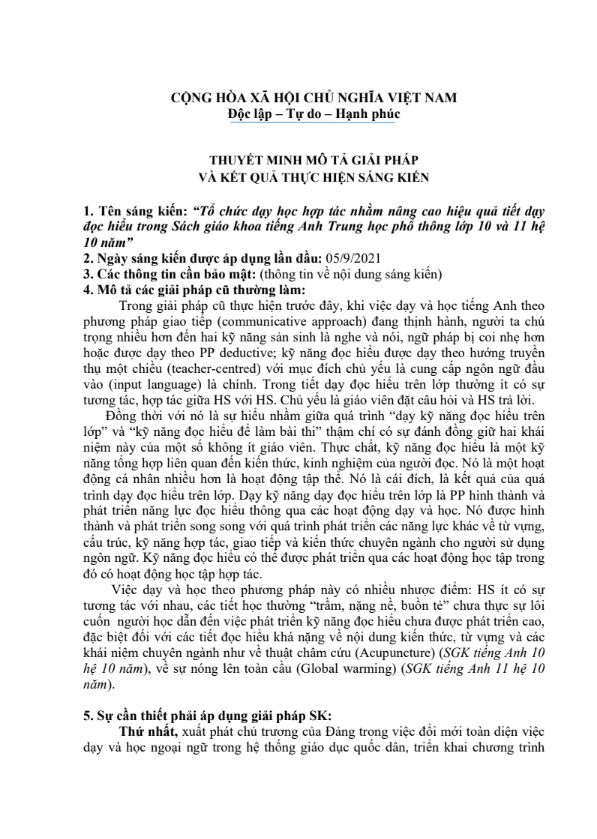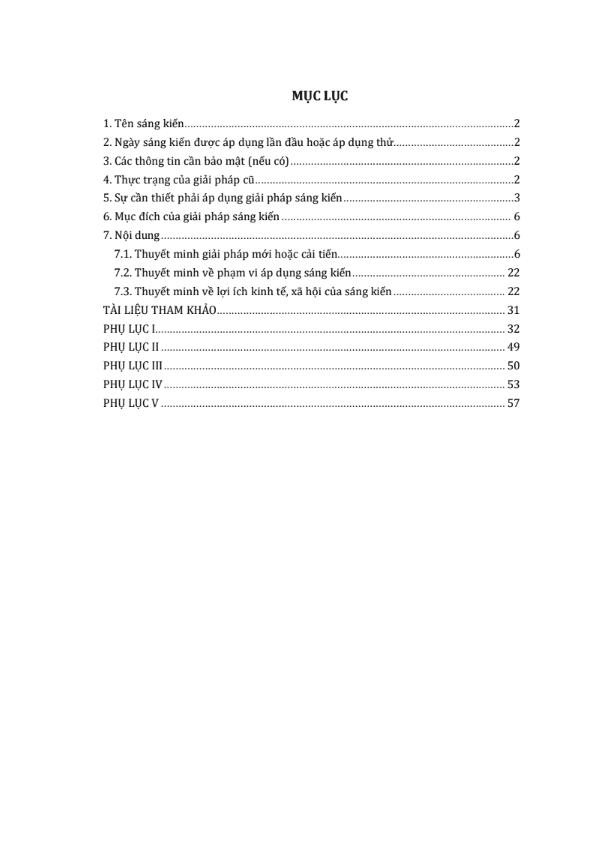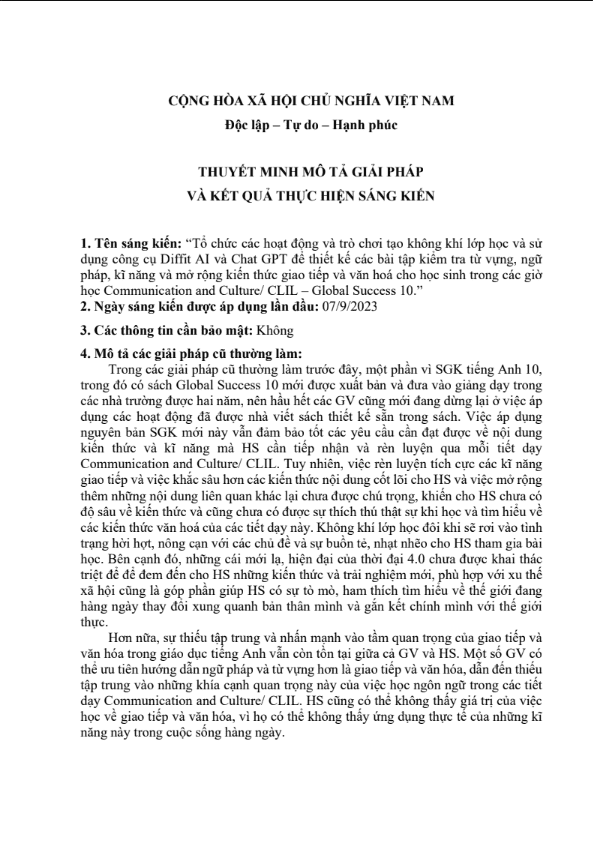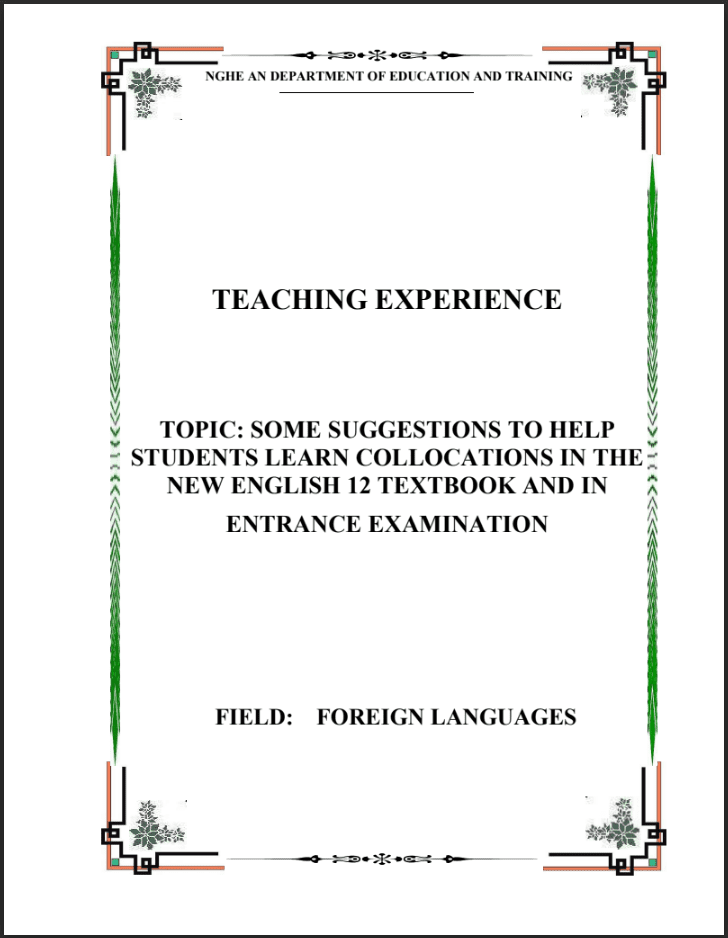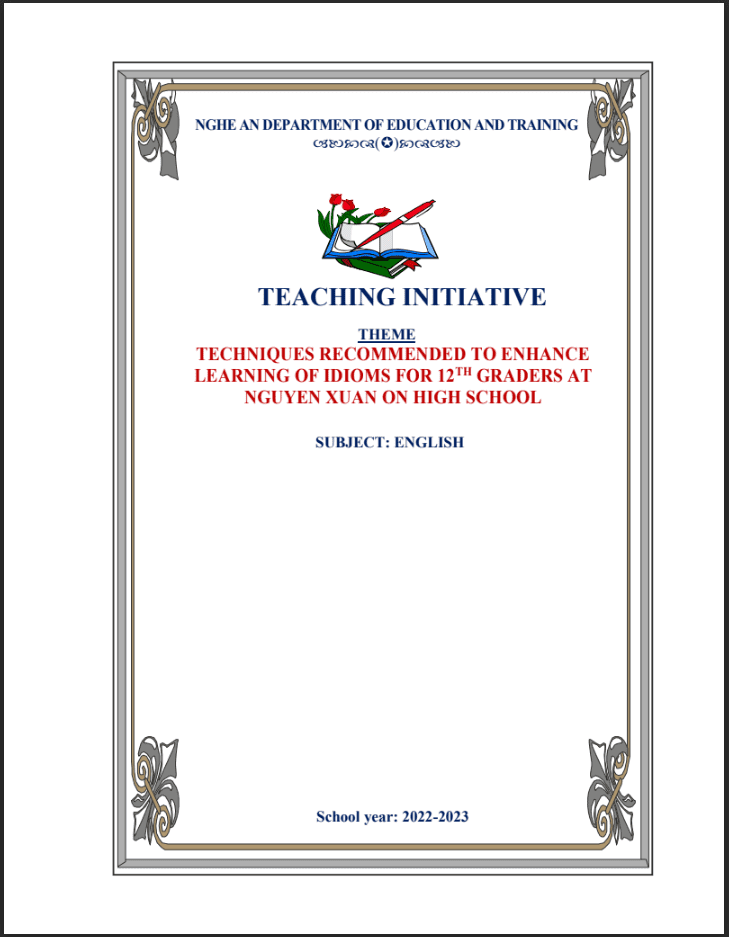SKKN Enhancing communicative competence for students through grammar lessons in English 10 – Global Success
- Mã tài liệu: MP0082 Copy
| Môn: | Tiếng Anh |
| Lớp: | 10 |
| Bộ sách: | Global Success |
| Lượt xem: | 422 |
| Lượt tải: | 6 |
| Số trang: | |
| Tác giả: | Đặng Thị Thanh Ngân |
| Trình độ chuyên môn: | Cử nhân đại học |
| Đơn vị công tác: | THPT Cửa Lò |
| Năm viết: | 2022-2023 |
| Số trang: | |
| Tác giả: | Đặng Thị Thanh Ngân |
| Trình độ chuyên môn: | Cử nhân đại học |
| Đơn vị công tác: | THPT Cửa Lò |
| Năm viết: | 2022-2023 |
Sáng kiến kinh nghiệm “Enhancing communicative competence for students through grammar lessons in English 10 – Global Success”triển khai gồm các biện pháp nổi bật sau:
Mô tả sản phẩm
PART A: INTRODUCTION
1
. Rationale:
Together with the advancement of science and technology, English as an
international language has become an indispensable tool for integration and
development among countries around the world. To many people, travelling abroad
for holiday, for jobs, for study or for business is a common thing and not beyond
their means. That is the reason why the demand of communicating in English is
getting higher and higher. Thus, teaching and learning English in the context of
globalisation has become more and more essential. English as a compulsory subject
in the national curriculum not only helps students broaden their knowlege of the
language in the most coutries all over the world but also improve their competence
of using the language in communication in order to meet the demand of high quality
workforce for the job market in the future. Therefore, the Ministry of Education and
Training issued Circular 32/2018/TT-BGDĐT in which the curriculum of the
English subject focuses on the communicative competence and considers learnered-
center approach as the main point of the teaching and learning process. The level of
upper secondary education requires students to be able to use English as a
communication tool as well as to enrich the knowledge of English through
phonetics, vocabulary and grammar lessons. To meet the requirements, the authors
have been applying various methods to encourage students to build up their
confidence and promote their communicative competence not only in skill lessons
but also in grammar lessons to replace the traditional method of teaching English
grammar – teachered-center. That is the reason why we have decided to choose the
carry out the topic: “Enhancing communicative competence for students through
grammar lessons in English 10 – Global Success”.
2
. Aim of the Study:
The topic was studied and applied with a view to enhancing the communicative
competence for grade 10 students through grammar lessons in the textbook English
1
0 – Global Success. It is also served as a source of materials that help English
teachers improve speaking skill for their students.
Through this study, the topic has helped the writers draw experiences of developing
the students’ communicative competence by teaching grammar communicatively.
The writers’ experiences shown in this study may provide English teachers with a
source of materials to teach grammar lessons in such a way that helps to improve
students’ communication skill in general.
3
. Scope of the study:
As mentioned at the beginning, the study attempts to figure out the methods of
teaching grammar communicatively for grade 10 students at Cua Lo high school.
Once successfully applied, a few activities used in teaching grammar towards
2
communicative approach will be suggested at Cua Lo high school.
. Method of the Study:
Studying the materials about teaching grammar communicatively in reference
books and materials available in the Internet.
4
–
–
–
Analyzing and drawing experiences from the process of teaching.
Applying in the real teaching to self-evaluate.
5
. Novelty of the Study:
It is possible that the topic of teaching grammar communicatively is not really
new in the field. Our topic, however, focuses on the communicative competence of
students in the particular grammar lessons in the coursebook English 10 – Global
Success, which has just been published and used on a large scale in this school year.
6
. Structure of the Study:
The Study is made up of three main parts as follow:
–
–
–
Part A: Introduction: To introduce the topic of the study and provide an
overview of the topic
Part B: Contents: To work out the definition of the terms used as well as
develop the topic
Part C: Conclusion: To draw the result and the feasibility of the topic
3
PART B: CONTENTS
- THEORETICAL BASIS OF THE TOPIC:
1
. Concept of teaching grammar communicatively
Generally, grammar shows the correct orders of words to make meaningful
sentences. “Grammar may be defined as the rules of a language, governing the way
in which words are put together to convey meaning in different contexts”.
(Nesamalar Chitravelu; Sararatha Sithamparam & The Soo Choon, 2005).
Traditional teaching methods follow the PPP pattern (short for Presentation –
Production – Practice) in which teachers present and illustrate the grammar rules and
students then use the prompts given to make similar sentences. In the Practice stage,
they continue praticing the controlled target laguage. For example, to teach the
present simple tense, the teacher introduces the verb form, the usage, the structures
and gives examples. Students take notes and follow the rules to put the verbs given
into the correcct form of the present simple tense. Then they practice making
sentences, using this verb form. In this model, the teacher plays the main role –
teacher-centered framework and learners study in a passive way – receiving the
“one-sided” knowledge. In this way, grammar points seem boring because they are
explained by teachers, memorized by students separately. Students focus on doing
exercises to indicate that they understand the lessons but they can hardly use these
rules to communicate. “The problem is not in grammar itself, but in the way, that
grammar has been taught and learned”. (https://elttguide.com/want-to-teach-
grammar-communicatively-its-so-simple-follow-these-3-tips/).
Teaching Grammar Communicatively means encouraging students to use
grammar points to communicate effectively in real life situations.
2
. Concept of communicative competence
In a broad meaning, the concept of communicative competence is a very
complicated term, which has been researched by famous scholars in the world for
years. “The scientific history of the concept of communicative competence began in
the 1960s as a counter-movement against the so-called “linguistic competence”
introduced by the structural linguist Noam Chomsky (1965), who based linguistic
theory on an ideal speaker-listener with perfect linguistic knowledge, which is
supposed to be unaffected by cognitive and situational factors during actual
linguistic performance. Among others, the philosopher Jürgen Habermas (1970) and
the sociolinguist Dell Hymes (1972) argued that Chomsky’s concept could not serve
as a relevant component in a theory of real-life communication. Habermas argued
“that general semantics cannot be developed sufficiently on the narrow basis of the
monological linguistic competence proposed by Chomsky” (1970: 137–138). But
similar to Chomsky’s idea of an idealized speaker-hearer, he idealized the speech
situation: “Above all, communicative competence relates to an ideal speech situation
4
TÀI LIỆU LIÊN QUAN
- 7
- 105
- 1
- [product_views]
- 5
- 173
- 2
- [product_views]
- 4
- 165
- 3
- [product_views]
- 4
- 129
- 4
- [product_views]
100.000 ₫
- 6
- 434
- 5
- [product_views]
100.000 ₫
- 2
- 507
- 6
- [product_views]
100.000 ₫
- 9
- 546
- 7
- [product_views]
100.000 ₫
- 4
- 409
- 8
- [product_views]
100.000 ₫
- 2
- 595
- 9
- [product_views]
100.000 ₫
- 0
- 538
- 10
- [product_views]

